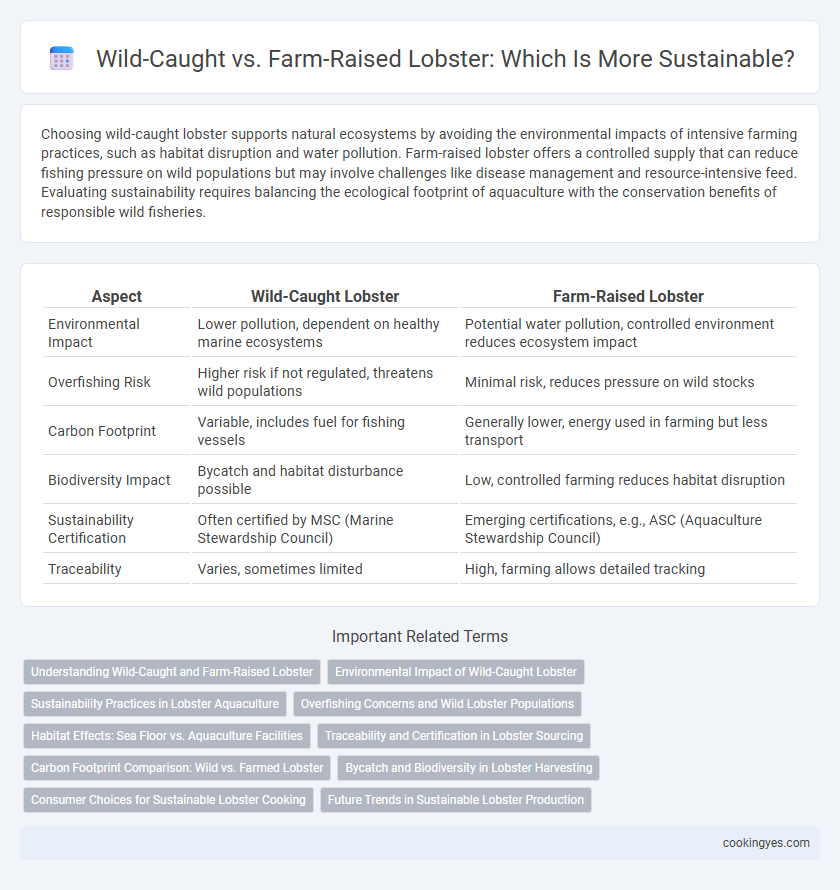Choosing wild-caught lobster supports natural ecosystems by avoiding the environmental impacts of intensive farming practices, such as habitat disruption and water pollution. Farm-raised lobster offers a controlled supply that can reduce fishing pressure on wild populations but may involve challenges like disease management and resource-intensive feed. Evaluating sustainability requires balancing the ecological footprint of aquaculture with the conservation benefits of responsible wild fisheries.
Table of Comparison
| Aspect | Wild-Caught Lobster | Farm-Raised Lobster |
|---|---|---|
| Environmental Impact | Lower pollution, dependent on healthy marine ecosystems | Potential water pollution, controlled environment reduces ecosystem impact |
| Overfishing Risk | Higher risk if not regulated, threatens wild populations | Minimal risk, reduces pressure on wild stocks |
| Carbon Footprint | Variable, includes fuel for fishing vessels | Generally lower, energy used in farming but less transport |
| Biodiversity Impact | Bycatch and habitat disturbance possible | Low, controlled farming reduces habitat disruption |
| Sustainability Certification | Often certified by MSC (Marine Stewardship Council) | Emerging certifications, e.g., ASC (Aquaculture Stewardship Council) |
| Traceability | Varies, sometimes limited | High, farming allows detailed tracking |
Understanding Wild-Caught and Farm-Raised Lobster
Wild-caught lobster populations are managed through regulated harvesting seasons and size limits to maintain ecosystem balance and ensure long-term sustainability. Farm-raised lobsters offer an alternative by reducing pressure on wild stocks, but challenges in replicating natural conditions and feed sourcing must be addressed for truly sustainable aquaculture. Evaluating the environmental impact, carbon footprint, and habitat preservation helps consumers make informed choices between wild-caught and farm-raised lobster.
Environmental Impact of Wild-Caught Lobster
Wild-caught lobsters have a lower carbon footprint compared to farm-raised counterparts due to minimal use of feed and energy-intensive infrastructure. However, challenges like habitat disruption and bycatch can impact marine biodiversity if not properly managed. Sustainable fishing practices and regulated quotas are essential to mitigate environmental damage and ensure long-term viability of wild lobster populations.
Sustainability Practices in Lobster Aquaculture
Sustainable lobster aquaculture emphasizes responsible farming methods such as maintaining optimal water quality, reducing chemical use, and implementing strict stocking densities to minimize environmental impact. Wild-caught lobsters benefit from natural ecosystems but face challenges like overfishing and habitat disruption, making farm-raised lobsters a viable alternative when sustainable practices are enforced. Advances in aquaculture technology and regulations help ensure lobster farming supports biodiversity, conserves resources, and meets market demand sustainably.
Overfishing Concerns and Wild Lobster Populations
Wild-caught lobster populations face significant overfishing pressures, raising sustainability concerns due to declining numbers and disrupted marine ecosystems. Farm-raised lobster offers a controlled alternative, reducing the demand on wild stocks and helping to preserve biodiversity. Sustainable fishing practices and aquaculture advancements are critical to balancing lobster supply with the health of wild populations.
Habitat Effects: Sea Floor vs. Aquaculture Facilities
Wild-caught lobsters thrive in natural sea floor habitats that support diverse marine ecosystems, maintaining ecological balance and promoting biodiversity. Farm-raised lobsters in aquaculture facilities often rely on controlled environments, which can reduce habitat disruption but may introduce challenges such as waste accumulation and water quality management. Sustainable lobster sourcing requires balancing the minimal habitat impact of wild capture with the environmental controls of aquaculture practices.
Traceability and Certification in Lobster Sourcing
Wild-caught lobsters offer higher traceability through established fishing quotas and monitoring systems, ensuring sustainable population management. Farm-raised lobsters provide certification opportunities under aquaculture standards, which help reduce pressure on wild stocks and promote environmentally responsible practices. Both sourcing methods benefit from traceability technologies like blockchain, enhancing transparency and consumer confidence in sustainable lobster products.
Carbon Footprint Comparison: Wild vs. Farmed Lobster
Wild-caught lobsters generally have a lower carbon footprint compared to farm-raised lobsters due to minimal energy input and natural ocean conditions. Farm-raised lobsters require controlled environments, feed production, and energy-intensive systems, increasing their greenhouse gas emissions. Sustainable seafood choices prioritize wild-caught options for reduced environmental impact, particularly regarding carbon emissions.
Bycatch and Biodiversity in Lobster Harvesting
Wild-caught lobster harvesting often results in lower bycatch rates compared to farm-raised lobster operations, which can disrupt local aquatic biodiversity through habitat alteration and waste accumulation. Wild fisheries, managed with regulated traps and seasonal restrictions, help maintain ecosystem balance by allowing lobster populations and associated species to thrive. Sustainable lobster practices prioritize minimizing bycatch and protecting marine biodiversity, ensuring long-term health of ocean environments and commercial viability.
Consumer Choices for Sustainable Lobster Cooking
Wild-caught lobster generally has a lower environmental impact due to natural population control and minimal habitat disruption compared to farm-raised lobster, which often requires resource-intensive feed and can contribute to water pollution. Consumers aiming for sustainable lobster cooking should prioritize certified wild-caught lobsters from well-managed fisheries that follow strict quotas and preserve marine ecosystems. Selecting lobsters labeled with sustainability certifications like the Marine Stewardship Council (MSC) ensures responsible harvesting practices and supports ocean health.
Future Trends in Sustainable Lobster Production
Wild-caught lobster populations face pressure from overfishing and environmental changes, prompting innovation in sustainable fishing practices like trap modifications and seasonal limits. Farm-raised lobster aquaculture is advancing through closed-loop systems and improved feed efficiency to reduce ecological impacts and disease risks. Future trends emphasize integrated multi-trophic aquaculture and genetic improvements to enhance lobster resilience and ensure long-term sustainability of lobster supply chains.
Wild-caught vs farm-raised lobster for sustainability Infographic

 cookingyes.com
cookingyes.com